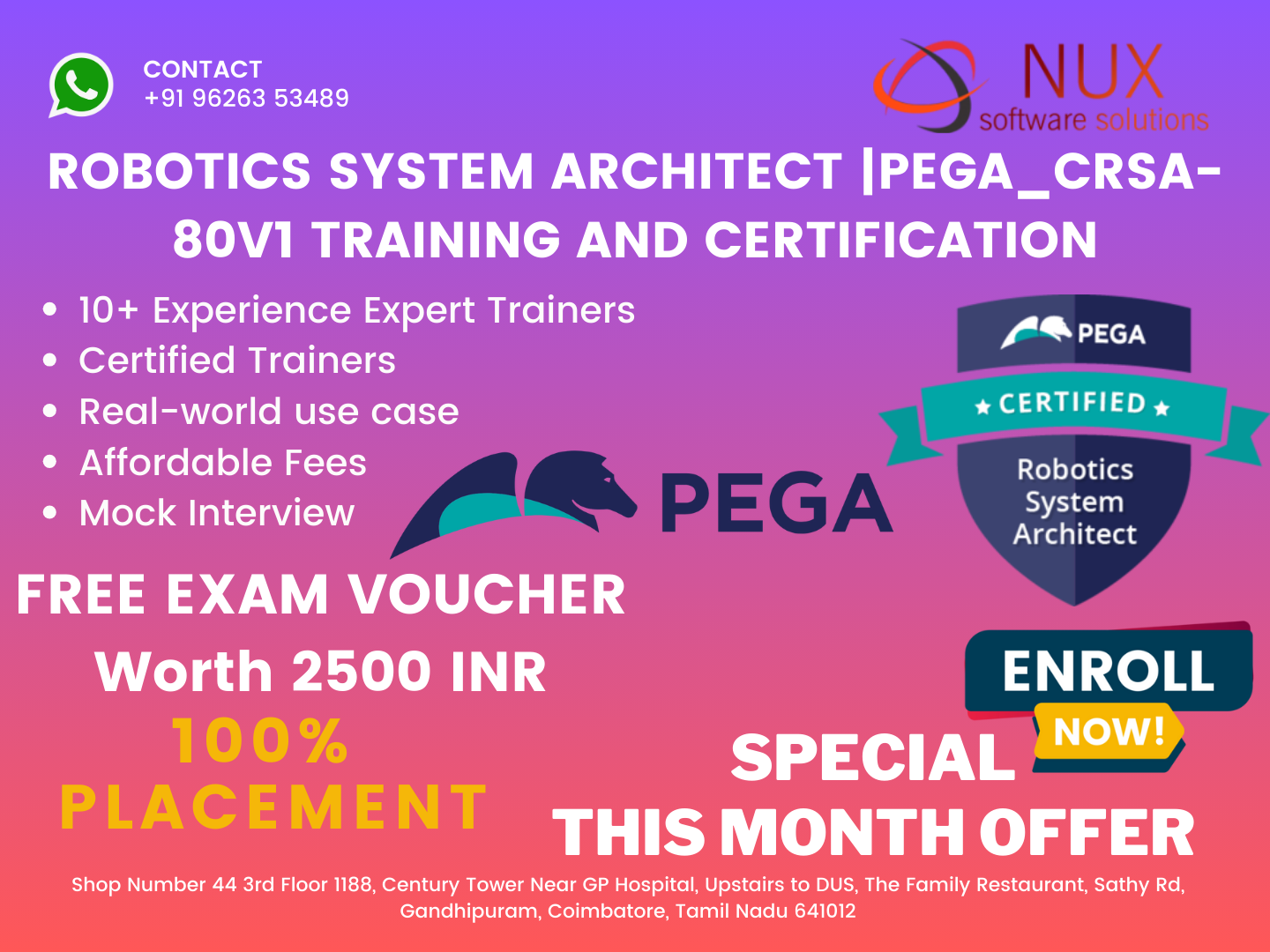Certified Pega Robotics System Architect Pega_CRSA-80V1


Best Training Institute in coimbatore for Pega Robotics System Architect Training and Certification.
Nux software Training & Certification Solutions seems to be quite enthusiastic about its AWS cloud training programs in Coimbatore! The emphasis on understanding AWS architectural principles and services, coupled with the broader perspective of how cloud computing is shaping IT architecture, suggests a comprehensive learning experience. How did you stumble upon this information? Are you considering cloud computing training, or was this just an intriguing find?.
Nux software Training & Certification Solutions is one of the best AWS training in Coimbatore, our institute is the leading AWS cloud training institute in Coimbatore and Tamilnadu. It has veteran employers equipped with technical skills and know how to design applications and systems on AWS. They assist the aspirants in building their technical skills as per the way to earn AWS training certification only through the way of recommended courses, labs, and exams.
Nux software Training & Certification Solutions ensures a conducive learning environment with a well-equipped lab. Accessible 24/7, the facility caters to professionals, corporate clients, individuals, and those undergoing live project or industrial training. This design allows for optimal hands-on experience and practical skill development, making it suitable for diverse training needs.
We have placed above 500 registered companies and 10000+ students and professionals, all are working in the reputed positions.
Course Syllabus
Pega Robotics System Architect,Pega_CRSA-80V1
Overview and Projects - 3%
- Identify the necessary architecture components for Pega Robotic Automations.
- Differentiate between the different architecture requirements for attended and unattended automations.
- Define the role of package storage in a Pega Robotic Automation.
- Communicate the role of Pega Robot Runtime in robotic automations and how it interacts with other applications.
- Describe the appropriate business use cases for Pega Robotic Process Automation.
- Explain what interrogation is in the context of a Pega Robotic Automation.
- Create a project through Quick Start.
- Describe the different project items in Pega Robot Studio.
- Navigate the Pega Robot Studio environment.
- Determine the correct Tool area of Pega Robot Studio based on development need.
Applications - 7%
- Recognize Pega Robot Studio application types.
- Recognize the most common applications used in Pega Robot Studio.
- Recognize the common Window application properties and values.
- Recognize the common Web application properties and values.
Interrogating and Recording - 15%
- Define the different types of step creation available in Intelligent Recording.
- Articulate the pros and cons of each type of step creation.
- Describe how to use the recording assistant after recording the steps for an automation.
- Describe interrogation within the context of a Pega Robotic Automation.
- Differentiate between the elements created during interrogation.
- Describe the purpose and use of the Interrogation Form.
- Differentiate between web and Windows interrogation.
- Restate the purpose of Global Web Pages during interrogation.
- Differentiate between different interrogation options on the Interrogation Form.
- Explain the purpose of performing application discovery.
- Describe when and how to use Microsoft Edge in IE compatibility mode.
- Restate the purpose of containers in a robotic project.
- Describe interrogating a single-page application.
- Articulate how to interrogate an HTML table.
Match Rules - 5%
- Restate how a robotic solution uses match rules during runtime.
- Relate best practices regarding match rules.
- Differentiate between the application of Windows and web-based match rules during interrogation.
- Differentiate between how web applications and IE compatible web applications match rules.
- Resolve common match rule situations and restate how controls can become unmatched.
- Explain the use of Xray Vision and its impact on application interrogation and automation development.
- Describe the purpose of UseKeys and how, once implemented, the UseKeys is applied within automation logic.
Automation Development - 20%
- Describe relationship between the Palette and automations.
- Describe the use of the Palette in automation development.
- Create an automation.
- Identify types of automation links and their relation to threading.
- Describe how automations are used with other automations and the project workflow.
- Create an automation as a sub-automation using the Label/Jump To components.
- Describe the importance of control availability in automation workflow.
- Describe how to access variable creation in a robotic automation.
- Restate the purpose of comparisons and expressions.
- Explain the expression input parameters.
- Describe the use of the utility components for strings, dates, times, and files.
- Differentiate the use and parameters of the Looping components.
- Describe the use and parameters of Wait components.
Advanced Automation and Best Practices - 15%
- Explain the use and development of Windows forms and application bars.
- Explain the scope and use of the Excel connector and other Microsoft Office connectors.
- Describe how to communicate with the user using messaging and notifications.
- Explain the importance and configuration of Assisted Sign-on.
- Differentiate between Start My Day and Assisted Sign-on.
- Recognize the uses for application methods and the Message Manifest feature.
- Describe the ways data flows between automation links and child blocks.
- Discover different approaches to working with data elements.
- Summarize the use of data elements on the automation surface.
- Identify how to add and switch between environments in your project.
Debugging and Diagnostics - 10%
- Recognize the reasons for using debugging for Pega Robot Studio.
- Implement the debugging process for the Run and Test modes.
- Use the keystrokes or toolbar options to step in, step over, and step out during a debugging process.
- Evaluate data values in an automation during debugging.
- Analyze the diagnostic settings to produce the necessary diagnostic log files.
- Implement a diagnostic log component to an automation to include specific text in a log file.
- Identify the new selections within the Tools menu to access the diagnostic log files.
- Use the project analysis feature to diagnose possible issues before deployment.
Pega Robotic Integration - 15%
- Differentiate the uses of attended and unattended uses and benefits.
- Differentiate between the architecture of how both attended and unattended automations function.
- Describe how and where to invoke automations.
- Recognize the which properties are available for data input/output for automations.
- Describe the statuses/messages returned by automations.
- Restate the necessary implementation options for messages for both attended and unattended automations.
- Configure the necessary settings for a robot activity to begin development of attended/unattended automations.
Deployment - 10%
- Identify the deployment package files.
- Define how to modify project properties for deployment.
- Recognize how to use the Project deployment dialog box to create and deploy packages.



